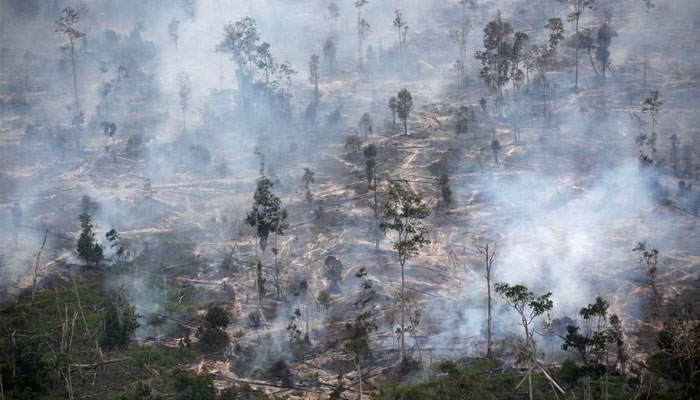Out of control: Forest fires are increasing in Pakistan
Recent wildfires in Balochistan destroyed almost 40% of the world’s largest pine nut (chilgozha) and wild olive forests
June 07, 2022

The recent forest fire in the Sherani district of Balochistan has burnt hundreds of thousands of pine and olive trees. This inferno destroyed almost 40% of the world’s largest pine nut (chilgozha) and wild olive forests spread over thousands of hectares.
Many species of birds and animals were killed in the fire. It took the army, local administration, FC, local volunteers and forest department officials more than two weeks to completely douse the fire. Despite efforts to bring the fire under control, the lack of resources and training prevailed over intention and will. The forest department and local administration were poorly equipped to deal with such a sustained and massive fire. And initially, the government didn’t do enough when the fire could have been extinguished through the use of helicopters.
The fire was spread over a more than 9km area. Three people lost their lives trying to control the fire and several others got injured. Pine nut is one of the most expensive nuts in Pakistan, eaten during the winter season. Not only that, but different species of animals and birds are also under threat.
This mountain range also connects the Balochistan, Punjab and Khyber Pakhtunkhwa provinces, and the forest is a source of livelihood for many local residents. Local people have not only lost their livelihoods as a result of these fires but the ecosystem of the area has also been badly affected. The federal and provincial governments should prepare a proper plan to launch a massive plantation drive to revive the forest.
It is worth mentioning here that only 1.4% of Balochistan’s massive land comprises forests, much lower than the national average of 4.8%. No real effort was made to increase the forest cover through the billion tree tsunami project of the PTI government. Nearly one million saplings were planted on 44% of the land mass of Pakistan.
We need a proper plan and coordinated efforts to rehabilitate this forest area. These forest fires have clearly exposed the fact that we are ill-prepared to deal with such disasters. We are a nuclear state but lack the necessary modern firefighting equipment, technology and trained human resource to extinguish such fires. Why is it that we had to borrow a firefighting jet from Iran to control the fire?
We need to fully equip and train the forest department officials and local populations to launch firefighting operations at the initial stages of wildfires. We should provide modern firefighting equipment at the local level in all the districts that host such large forests.
When the forest fire was burning the forest in Sherani, two other major forest fires erupted in Tirah Valley and Buner in Khyber Pakhtunkhwa. The rising temperatures and drought-like conditions as a result of climate change seem to be the major reasons for increased forest fires in the recent period. Callous human behaviour is another reason that is triggering these forest fires.
Data shows that KP lost more than 1.2 million trees to forest fires in 2018-19. Official documents reveal that the number of fire incidents increased in 2018-19 as compared to 2015-16, 2016-17 and 2017-18. According to them, fires occurred at 139 sites affecting a total area of 1,735.46 hectares in 2018-19. In contrast, fires only affected 370 hectares in 2015-16. The number grew to 1,414.2 hectares and 2,793.2 hectares in the two years that followed.
The two major forest fires in 2021 burnt thousands of trees in the Galiyat area and Buner district. Wildfire incidents have become a common phenomenon in the forest range of Galiyat and every year precious trees and wildlife are destroyed in large numbers due to the negligence of the concerned department.
The wildfire issue is of grave concern and needs serious attention by the government. Unfortunately, the forest department had failed to devise a strategy to overcome the threat of forest fires which end up destroying thousands of trees every year. Hundreds of hectares of precious forests are lost every year due to forest fires, illegal logging, overharvesting of wood for fuel and charcoal, and increased small-scale farming in the country.
There is no doubt that forest fires are devastating for our forests – burning trees and killing many species of birds and small animals every year. But there is also another threat to Pakistan’s green cover: the illegal logging of thousands of trees every year by the timber mafia.
This illegal activity is forcing birds and animals to migrate to other areas. It is disturbing the ecosystem and causing damage to the environment. Both are contributing to deforestation in Pakistan. Unfortunately, we are failing on both fronts to protect our precious forests. We have not only witnessed an increase in the incidents of forest fires in recent times but also of illegal logging by the timber mafia, with deforestation taking place at a disturbingly rapid pace.
Pakistan is already a forest-poor country as only 4.8% of its land is covered with forests. The global average is 31%. Even South Asian countries like India, Bangladesh and Sri Lanka have 24%, 14% and 34% of their land mass covered with forests and plants.
We need to increase the forest cover to lower the impacts of global warming, climate change and to slow down the process of environmental degradation. Pakistan has 4.2 million hectares of forest and planted trees. That means only 0.05 hectare of forest per capita against a world average of 1.0 hectare. This is an alarming situation and needs proper attention. We need to plant more trees than we lose every year due to different factors. We need a national action plan to protect our forests.
The writer is a freelance journalist.
Originally published in The News









